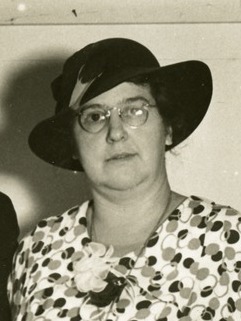
Anna Jane Harrison was an American organic chemist and a professor of chemistry at Mount Holyoke College for nearly forty years. She was the first female President of the American Chemical Society, and the recipient of twenty honorary degrees. She was nationally known for her teaching and was active nationally and internationally as a supporter of women in science.
AllieVibert Douglas,, who usually went by her middle name, was a Canadian astronomer and the first Canadian woman to become an astrophysicist.
Marguerite Davis was an American biochemist, co-discoverer of vitamins A and B with Elmer Verner McCollum in 1913. Their research greatly influenced later research on nutrition.

Ethel Ronzoni Bishop was an American biochemist and physiologist.
Leonora Bilger was an American chemist who studied nitrogenous compounds. She was a noted teacher and administrator at the University of Hawaii for the majority of her career.
Helen M. Dyer was an American biochemist and cancer researcher. Her main work concerned the mechanism of carcinogenesis; she also worked with metabolism and nutrition.
Dorothy Anna Hahn (1876–1950) was a lifelong educator and American professor of organic chemistry at Mount Holyoke College. Her research utilized the then newly developed technique of ultraviolet spectroscopy to study hydantoins.
Frances Gertrude Wick was an American physicist known for her studies on luminescence.
Grace Medes was an American biochemist, who discovered tyrosinosis—a metabolic disorder today known as tyrosinemia—and studied fatty acid metabolism. She was awarded the Garvan-Olin Medal in 1955 for her work.
Mary Louisa Willard was internationally recognized for her work in microscopy and forensic science. She began working at Pennsylvania State University as an assistant in 1921, and retired as professor emerita in 1964. She assisted law enforcement officers throughout her career and after her formal retirement, often without pay.

Madge Thurlow Macklin was an American physician known for her work in the field of medical genetics, efforts to make genetics a part of medical curriculum, and participation in the eugenics movement.
Dorothy Virginia Nightingale was an American organic chemist who is known for research on chemiluminescence and the Friedel-Crafts reaction. Nightingale directed the research of 24 PhD students and 26 Masters students and authored 56 scientific publications.
Alice Emily Smith was a British chemist and one of the nineteen signatories of the 1904 petition to the Chemical Society.
Margarethe Meta Kunde was a German-born, American physician and physiologist.
Ida Kraus Ragins, née Kraus, was a Russian Empire-born American biochemist.
Elisabeth Dane, was a German biochemist.
Genrietta Dokhman was a Soviet geobiologist and phytocenologist.
Iulia Dombrovskaia was a Russian pediatrician.
Betty Julia Sullivan was an American biochemist between the 1920s and 1940s at Russell Miller Milling Company. In 1947, Sullivan began her executive career as research director and vice-president for Russell Miller until the company became part of Peavey Company in 1958. After the merger, Sullivan remained in her executive roles before leaving in 1967 to co-start an agribusiness consulting company. While working at Experience Inc., Sullivan became director of the company in 1975 and retired in 1992. During her career, Sullivan was the first woman to receive the Osbourne Medal from the American Association of Cereal Chemists, in 1948. In 1954, Sullivan was awarded the Garvan–Olin Medal from the American Chemical Society.
Anna Isobel McPherson (1901-1979) was a Canadian physicist and the first female professor in the Department of Physics at McGill University.


